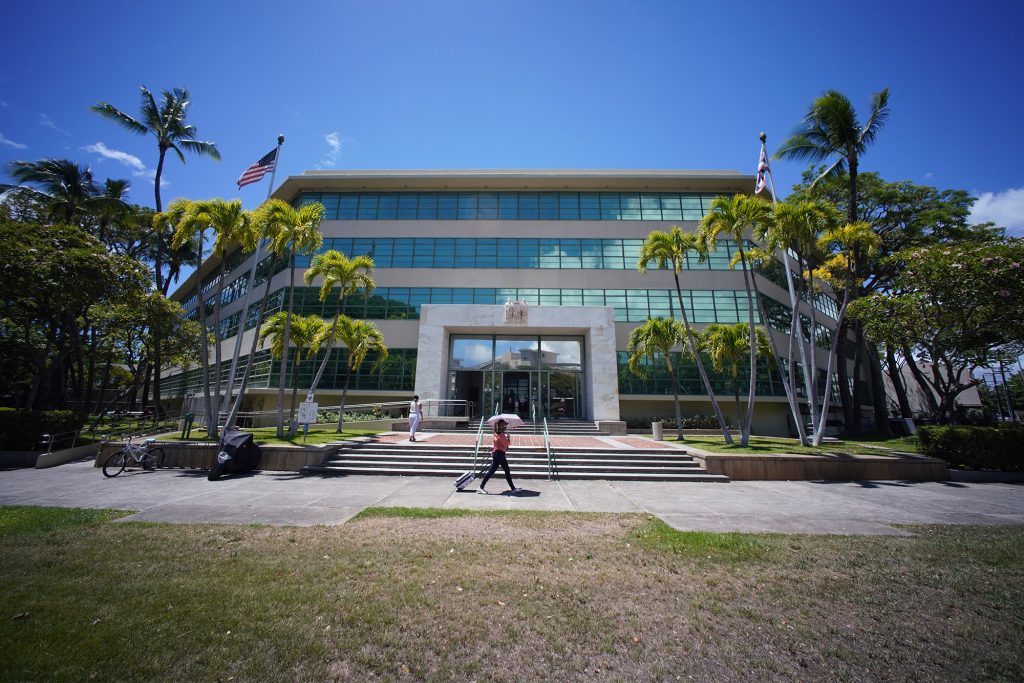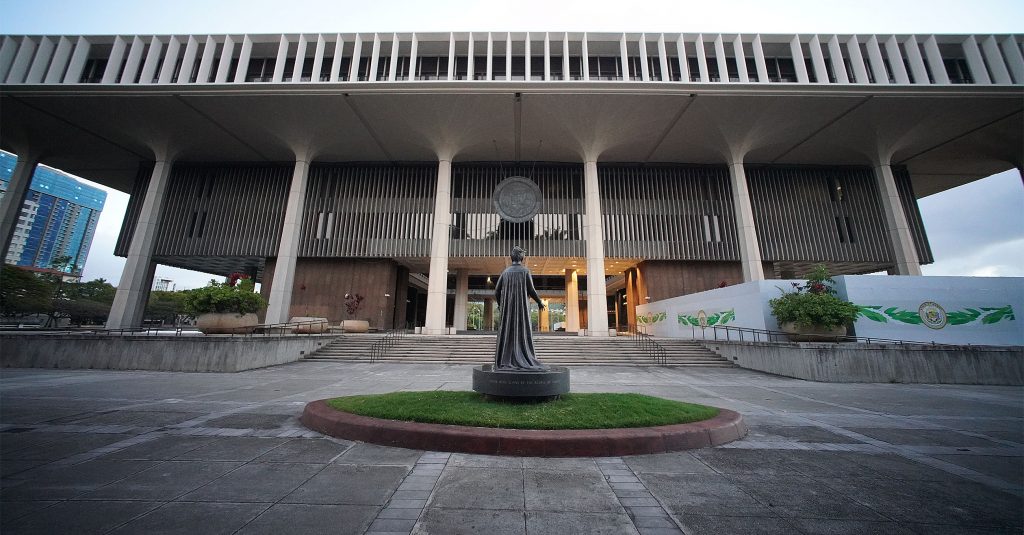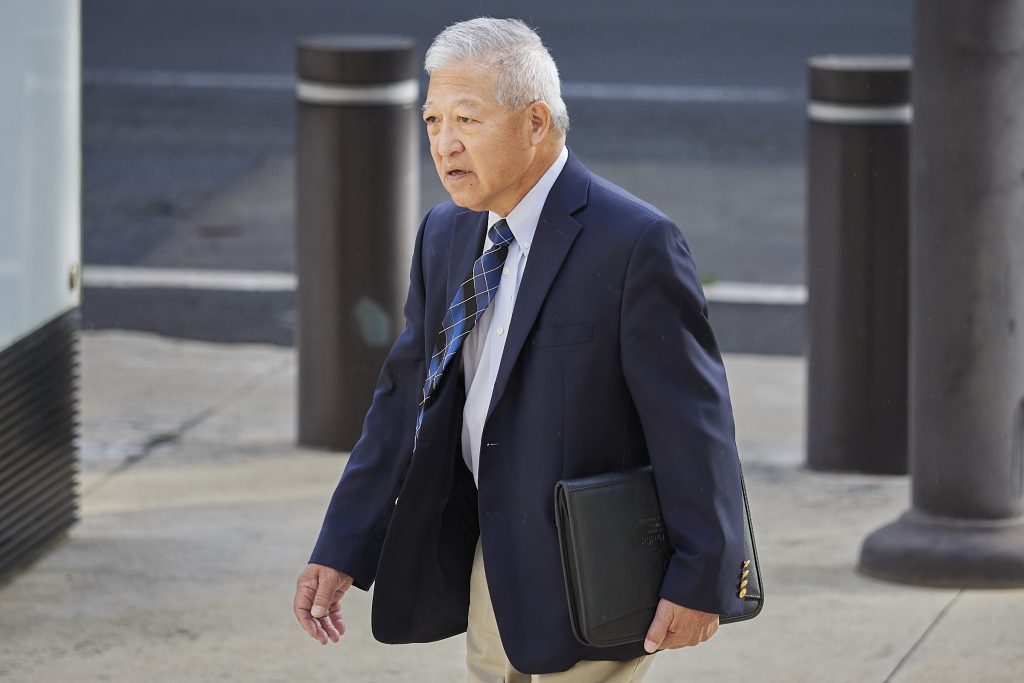As Oahu residents reel from the news that military families’ drinking water was contaminated with petroleum, and that water for the broader community is also at risk, scrutiny of the nearby Navy’s fuel facility is intensifying.
But the crisis is not a surprise to many residents, officials and local environmental advocates. For years, they’ve considered Red Hill an inevitable environmental and public health disaster.
“My fear was that something terrible would happen before people wake up and this comes to their attention,” Ernie Lau, chief engineer of the Honolulu Board of Water Supply, said this week.

The military said it caught wind of the emergency over Thanksgiving weekend as complaints rolled in from military housing residents saying that their water smelled of fuel and that their families and pets were falling ill. After initially dismissing concerns, the Navy later acknowledged that the Red Hill well that services that community was contaminated.
Civil Beat has been reporting on the leaking tanks, water contamination and political debate over Red Hill since 2014. Read our coverage here. Click on “full archive” for the complete list of stories.
State health officials announced on Friday that the Navy’s water system contained levels of gasoline and diesel range hydrocarbons as much as 350 times higher than state standards for safe drinking water.
The cause of the problem is still under investigation, but the suspected source is the Navy’s World War II-era Red Hill fuel facility located uphill from the affected military communities.
Red Hill Bulk Fuel Storage Facility is made up of 20 massive pill-shaped fuel tanks and a system of pipelines that use the force of gravity to deliver fuel to Pearl Harbor, 2.5 miles away. Each tank stands taller than the Hawaii Capitol building and is large enough to contain Aloha Tower.
It sits underground to the east of the Halawa Correctional Facility along the western edge of the Koolau mountain range, which divides the Halawa and Moanalua valleys.
The tanks are aligned in two rows of 10 connected by a system of upper and lower underground concrete tunnels and pipelines.
This video, produced by Navy Region Hawaii, shows what it looks like inside the facility:
The whole facility, which generally holds about 180 million gallons of fuel, sits just 100 feet above a groundwater aquifer that supplies 77% of the island’s total water, according to the Department of Health.
Built in haste in the early 1940s for World War II, the tanks were constructed by workers who blasted cavities into the mountain’s volcanic rock and built the tanks into the holes.
Each of the tanks are made of a thin steel liner – about a quarter of an inch thick – that is now corroding, encased by a concrete shell that the Navy admits it cannot access and is therefore impossible to maintain. The pipeline system attached to the tanks is just as old as the tanks themselves.
Since 1943, the facility has recorded at least 73 fuel leaks totaling at least 180,000 gallons, according to the Sierra Club, although the Navy disputes this.
The Navy says that Red Hill is a vital national security asset used by the U.S. Air Force, Army, Marines, Navy, Coast Guard and Hawaii National Guard.
Military officials say that the facility is still needed for the “mission readiness” of the U.S. Indo-Pacific Command amid what it considers increasing aggression from Russia and China. They have also promoted Red Hill as a vital fuel source in the case of a state emergency or natural disaster. In that scenario, Red Hill could supply fuel to the airport, Honolulu Harbor, Hawaiian Electric and ships and aircraft, according to the Navy.
Around 2008, the Hawaii Department of Health recommended that the Navy install a leak detection system and groundwater monitoring wells to protect the drinking water. Even at that time, petroleum contamination was evident underneath the tanks, according to DOH. The Honolulu Board of Water Supply’s Halawa shaft, which provides 20% of the drinking water for the region, is less than a mile away.
However, the facility escaped major scrutiny until 2014, when an estimated 27,000 gallons of fuel escaped from one of the tanks. After that release, groundwater and soil monitoring systems registered spikes in diesel and petroleum, according to DOH.

The Navy blamed the catastrophe on errors by a contractor, but a systems analyst told KITV in 2015 that alarms indicating a leak were ringing for about a month but were ignored by officials.
The DOH said earlier this year that the Red Hill facility’s location above the aquifer is inherently dangerous, and the DOH Environmental Health Administration stated in July that it doesn’t believe Red Hill can operate in a way that protects human health and the environment.
Meanwhile, other Navy hubs across the country have shuttered their own underground fuel facilities built in the same era as Red Hill.
Officials in Washington called the Navy’s shutdown of their region’s World War II-era fuel tanks a win for taxpayers, the environment and the military, the Kitsap Daily News reported.

Navy officials in Hawaii have resisted doing the same here. They have long said that they can continue to use Red Hill as a strategic military asset and also protect human health and the environment.
“We can do both,” Navy Capt. Gordie Meyer, the commanding officer of the Naval Facilities Engineering Systems Command, said at a meeting in October. “It’s not a matter of one or the other.”
Navy officials suspect the water contamination crisis was caused by leaks that occurred this year: On May 6, over 1,600 gallons of fuel spilled from a burst pipeline in the facility’s lower access tunnel. And on Nov. 20, 14,000 gallons of water and fuel leaked from a fire suppression line in a tunnel at the halfway point between the tanks and the Red Hill drinking water shaft.
The Navy’s Red Hill water shaft, located a half-mile from the fuel tanks, is one of three water sources that feed into the Joint Base Pearl Harbor-Hickam system and is now significantly contaminated with JP-5, or jet fuel, the Navy told state and local officials this week.
Diesel contamination is also present near a second water source, the Navy’s Aiea Halawa shaft, the Navy announced this week.

The contamination impacts the entire JBPHH system, which is interconnected and serves 93,000 people in communities including the Aliamanu Military Reservation, the Pearl Harbor Peninsula, Ford Island and Iroquois Point.
But the presence of that fuel-laced water in or near the Navy’s wells also means that the drinking water for the region – 400,000 people from Moanalua to Hawaii Kai – is also at risk. The Navy and the Honolulu Board of Water Supply pump their water from the same aquifer. It’s like two straws drinking from the same glass.
While aquifers are sometimes misunderstood to be underground lakes, Oahu’s aquifer is made up of water trapped in the pores of lava rock.
According to BWS, there is no natural barrier stopping the Navy’s contamination from migrating across the Halawa valley to the civilian water source. A cause for additional concern is that BWS officials don’t have a sense of how bad the contamination is, where exactly it’s coming from or how fast it might be moving. The Navy has been slow to share information, they said.
But they’re erring on the side of caution. BWS’s Halawa shaft has been shut off since Dec. 2. BWS also shut off two additional wells after the Navy reported this week that there was diesel contamination near its Aiea Halawa shaft.

The Halawa shaft is particularly vulnerable to contamination because it sucks water right from the top of the aquifer, according to the BWS, and oil floats on water.
BWS officials said they don’t believe it’s feasible to drill a deeper well there. It would make more sense to drill another one further away from the contamination, they said.
Once an aquifer is significantly contaminated, there isn’t much that can be done, BWS said. Water can be decontaminated once it’s pumped from the aquifer, but that option becomes less feasible the greater the contamination, Kawata said. At a certain point, it becomes cost-prohibitive. Plus, there is no water treatment facility capable of doing that kind of filtration right now. The only processing BWS water undergoes is chlorination.
Kawata offered the analogy of a casserole.
“You’re baking a casserole and you want to add salt to taste,” he said. “You add a pinch of salt, no problem. But now you accidentally pour in two cups … your ability to save the casserole is no longer there.”
With three of its wells shuttered for now, the Board of Water Supply is relying on other wells closer to Diamond Head to meet the water demands of urban Honolulu and beyond. While that water is still part of the same aquifer, the wells are farther from the contamination, and BWS believes the pollution would travel westward, not toward Diamond Head.
But those sources can’t replace the wells that were shut down, BWS officials said.

“You can sustain that for short periods,” said BWS program administrator Erwin Kawata. “But not long periods, like years.”
Pumping those wells at a higher rate could stress the aquifer, Kawata said. Overpumping risks draining the aquifer of so much fresh water that it starts to draw in the saltier water underneath.
“The idea of all this pumping is to pump at the rate that nature recharges,” he said.
During the wetter winter months, when BWS customers are using less water, it’s easier. But come summertime, Lau said customers may have to cut back. BWS is currently making lists of their biggest water users in preparation to ask them to reduce.
“If demand exceeds supply of other existing wells, we might have to ask for voluntary or even mandatory conservation,” he said. “We ask the kokua of customers to take on personal responsibility to manage your water use and not waste it.”
For now, BWS says its customers don’t have to worry about buying bottled water and that it is constantly testing its system for signs of trouble.
If any BWS customers notice problems with their water, they are encouraged to call BWS. Household water filters and reverse osmosis devices have only a “marginal” impact on fuel-contaminated water, according to Kawata, and shouldn’t be counted on in a contamination crisis.
Today’s water contamination crisis was a disaster years in the making, and it came with ample warning.
An analysis by the Navy in 2009 predicted that a fuel leak of only 16,000 gallons could poison the military’s own water supply with benzene, a known carcinogen. Nearly 16,000 gallons of fuel and fuel-laced water have leaked from Red Hill pipes above the aquifer just this year. Additional gallons have leaked into Pearl Harbor.
The Department of Health and the U.S. Environmental Protection Agency put the Navy on a performance improvement plan after the 2014 leak that required the Navy to upgrade its facility to protect the aquifer by 2037, but the Navy has openly stated its intention to blow the deadline.

In 2019, officials pledged to either invent a secondary containment strategy – a tank within a tank solution that does not currently exist – or empty the tanks by 2045.
Navy officials have consistently promised that everything will be fine.
“It’s decades old, but it’s in good shape,” Navy Capt. Marc DeLao, the former commanding officer of Naval Facilities Engineering Command Hawaii, said in 2020. “The tanks are not leaking.”
And yet, during any given year, there is a 27.6% chance of a leak of up to 30,000 gallons of fuel, according to a 2018 report by a Navy consultant. And that doesn’t take into account additional risks related to fire, flooding or earthquakes. The report also expects a chronic risk of 5,803 gallons being released per year.
But the Navy has downplayed those findings, telling regulators that it disagrees with its consultant’s conclusions.
When a pipeline connected to the Red Hill facility was found to be leaking into Pearl Harbor earlier this year – just days before the Navy was set to appear before the Department of Health in a consequential hearing – officials kept the information to themselves for months.
In an email to colleagues, a Navy official said he didn’t want activist organizations to use news of a leak against them.
The fuel release would’ve undermined the Navy’s official stance that the 2014 leak was an aberration and that something like that could never happen again.

“People can rest assured that what happened in 2014, that type of event could not happen again with the procedures we have in place now,” Navy Rear Adm. Robert Chadwick told Civil Beat in 2019.
When residents began to report the smell of fuel in their drinking water, the Navy’s first response was to deny it.
“I can tell you at this point that there are no immediate indications that the water is not safe,” Navy Capt. Erik Spitzer said in an email to residents on Nov. 29, the day after complaints about the water began flooding in.
“My staff and I are drinking the water on base this morning, and many of my team live in housing and drink and use the water as well.”
Last Monday, Gov. David Ige ordered the Navy to suspend all operations at Red Hill, build a water treatment facility and provide a plan within 30 days for emptying the tanks. The Navy is now fighting the order to empty the tanks, a position that could lead to a prolonged legal battle.
The governor’s order represents a significant shift in the political winds on an issue that many activists have felt was not taken seriously for years.
Since 2014, the Board of Water Supply has raised alarms alongside the Sierra Club of Hawaii and a small group of community members who have been calling for the shutdown of Red Hill. But elected officials were not on board.

Until very recently, the Hawaii Department of Health did not regulate the Navy’s fuel storage system. While it acknowledged its role to provide oversight to civilian underground fuel storage facilities, it specifically exempted Red Hill. It took a lawsuit by the Sierra Club of Hawaii to force DOH to regulate the facility.
That case, which the Sierra Club won in 2018, is the reason the Navy had to apply for a state permit for the very first time in 2019. BWS and the Sierra Club have contested that permit, and the case is ongoing. But the permitting process means that Health Director Libby Char has the power to approve or reject the Navy’s application. DOH inspected Red Hill for the first time last year, a visit that led to a $325,000 fine for environmental violations.
Even as recently as a few weeks ago, Hawaii’s congressional delegation was not supportive of the idea of closing Red Hill down.
But now that fuel has hit people’s faucets, Sen. Mazie Hirono and Rep. Ed Case said “all options are on the table.”
 Sign up for our FREE morning newsletter and face each day more informed.
Sign up for our FREE morning newsletter and face each day more informed.
Civil Beat is a small nonprofit newsroom that provides free content with no paywall. That means readership growth alone can’t sustain our journalism.
The truth is that less than 1% of our monthly readers are financial supporters. To remain a viable business model for local news, we need a higher percentage of readers-turned-donors.






